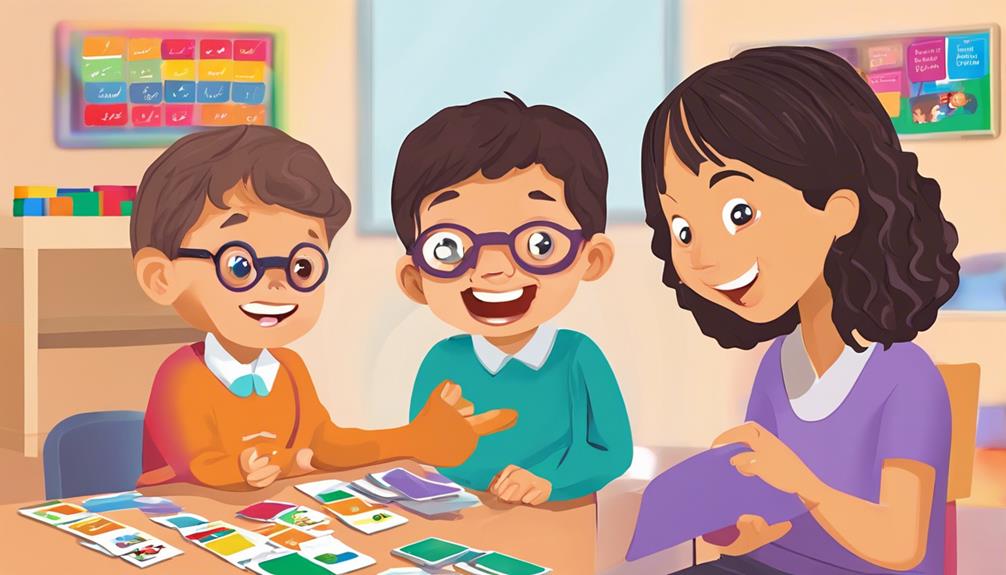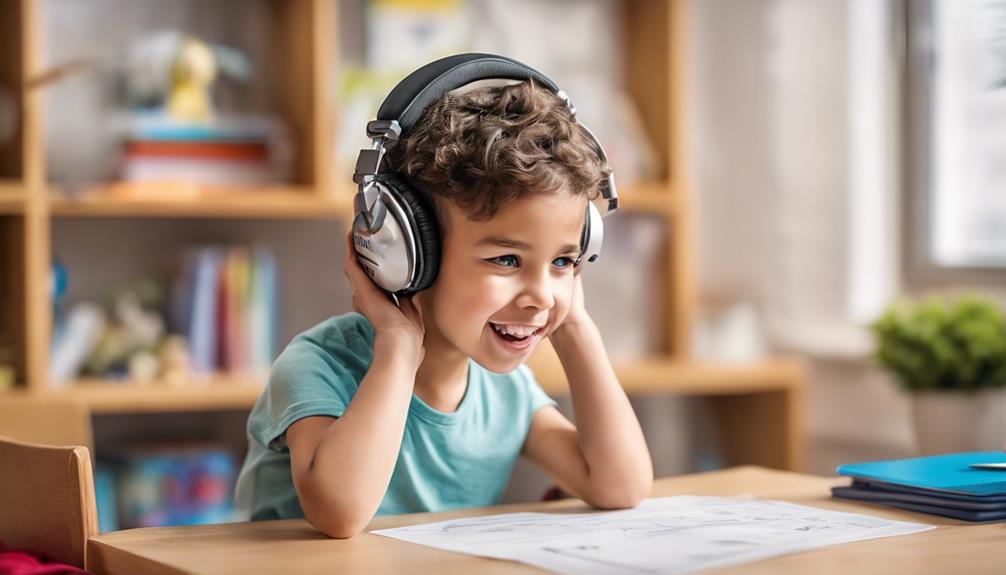When dealing with Auditory Processing Disorder (APD), using speech therapy techniques can bring both challenges and rewards. Exploring the intricacies of auditory discrimination, the timing of hearing, and language processing skills can lead to significant improvements for individuals with APD.
As we delve into the realm of 5 key techniques employed in APD therapy, we uncover a world where sound discrimination training, auditory memory exercises, and language-processing strategies play pivotal roles in transforming communication abilities.
Stay tuned as we unravel the impact of these techniques on enhancing the lives of those with APD.
Key Takeaways
- Enhance auditory discrimination and language processing skills for improved speech therapy outcomes.
- Improve auditory memory through repetition, segmentation, and mnemonic devices.
- Integrate multisensory stimuli to enhance sensory processing and communication skills.
- Develop metacognitive skills for self-awareness and problem-solving in auditory challenges.
Auditory Discrimination Exercises
In Auditory Discrimination Exercises, we focus on enhancing our ability to distinguish similarities and differences in sounds. These exercises are designed to help improve our auditory discrimination skills, enabling us to identify subtle variations in sound patterns.
By engaging in activities such as matching similar or different sounds, identifying sound patterns, and categorizing sounds based on similarities, we can strengthen our auditory processing abilities crucial for language development and effective communication.
For individuals with Auditory Processing Disorder, these exercises play a vital role in improving their capacity to interpret and respond to auditory information accurately. By practicing auditory discrimination, individuals can become more adept at recognizing and understanding the nuances present in various sounds, ultimately enhancing their overall auditory processing skills.
Through consistent participation in these exercises, individuals can make significant strides in their ability to differentiate between sounds and effectively process auditory information, leading to improved communication and language skills.
Language Processing Activities

Language processing activities focus on strengthening auditory memory, sequencing, and discrimination of speech sounds in individuals with auditory processing disorder, enhancing their overall communication abilities. These activities are designed to improve skills such as vocabulary, grammar, sentence structure, and comprehension. By engaging in therapy techniques that involve practicing listening, speaking, reading, and writing tasks, individuals can enhance their communication abilities in various social and academic settings. Here's a table illustrating some common language processing activities:
| Language Processing Activities | Description | Benefits |
|---|---|---|
| Listening exercises | Practice active listening skills | Enhances comprehension |
| Speaking drills | Work on articulation and fluency | Improves verbal skills |
| Reading comprehension tasks | Focus on understanding written text | Enhances literacy |
Engaging in these activities can help individuals with auditory processing disorder communicate more effectively and confidently. It's essential to tailor these exercises to the specific needs and abilities of each individual to maximize their progress and success in improving language processing skills.
Auditory Memory Strategies
Auditory memory strategies play a crucial role in enhancing the ability to remember and recall auditory information for individuals with Auditory Processing Disorder. In speech therapy, these strategies aim to improve auditory memory skills through various techniques.
Repetition exercises help reinforce the retention of auditory information, while chunking information into smaller, more manageable segments can aid in processing longer sequences. Mnemonic devices, such as acronyms or rhymes, provide additional memory cues for better recall.
Speech therapists may introduce activities like listening to and remembering specific sounds or words to strengthen auditory memory in a structured manner. Visual aids and multisensory approaches, incorporating sight and touch alongside auditory input, can further support the development of auditory memory skills during therapy sessions.
Multisensory Integration Techniques

Using a blend of auditory, visual, and tactile stimuli, multisensory integration techniques are designed to enhance processing and comprehension in individuals with Auditory Processing Disorder (APD). These techniques aim to strengthen connections between different sensory modalities, improving sensory processing and integration.
By engaging multiple senses simultaneously, multisensory approaches help individuals with APD better understand and interpret auditory information. Activities incorporating multisensory integration support learning, memory, and communication skills in those with APD.
Through the incorporation of various sensory inputs, these techniques enhance the brain's ability to process and comprehend auditory information. By utilizing multisensory integration techniques, individuals with APD can experience improved sensory processing, leading to enhanced comprehension and communication abilities.
The synergy of auditory, visual, and tactile stimuli plays a vital role in facilitating a more comprehensive understanding of auditory information for individuals with APD.
Metacognitive Training Exercises
In helping individuals with Auditory Processing Disorder (APD) navigate auditory challenges more effectively, metacognitive training exercises focus on enhancing self-awareness and cognitive regulation related to processing auditory information. These exercises play a crucial role in therapy by:
- Teaching individuals to monitor their cognitive processes when dealing with auditory stimuli.
- Improving awareness of how they process auditory information.
- Enhancing self-regulation strategies to manage auditory challenges effectively.
- Developing problem-solving skills to address difficulties in processing auditory information.
Frequently Asked Questions
How to Treat Auditory Processing Disorder in Speech Therapy?
We focus on treating auditory processing disorder in speech therapy by tailoring techniques to enhance auditory discrimination, memory, sequencing, and attention skills.
Our goal is to boost communication effectiveness and auditory information processing. Therapy intensity aligns with the individual's APD type and severity for optimal outcomes.
We utilize various methods, from sound discrimination training to language-processing strategies, to address APD effectively and improve overall auditory processing abilities.
What Are the Teaching Strategies for Auditory Processing Disorder?
We've discovered effective teaching strategies for auditory processing disorder that enhance discrimination, memory, sequencing, and attention skills. By incorporating multisensory approaches, visual aids, and repetition, we've seen significant improvements in auditory processing abilities.
Structured routines in therapy sessions create a secure and engaging environment. Clear, concise instructions and breaking down tasks into manageable steps have supported learning. Encouraging active listening, self-monitoring, and self-advocacy skills empower individuals in various settings.
What Tools Help Auditory Processing Disorder?
When it comes to tools for auditory processing disorder, options like FM systems, assistive listening devices, and noise-canceling headphones can make a big difference. Visual aids such as charts, graphs, and pictures can also be incredibly helpful.
Speech therapy tools like sound discrimination activities, auditory memory games, and language processing exercises can aid in improving auditory processing skills. Computer-assisted programs and apps designed for auditory training are effective too, as are environmental modifications like reducing background noise and using visual cues.
What Are Coping Strategies for Apd?
We understand coping with APD can be challenging, but we've got your back! Utilizing visual aids, preferential seating, and asking for clarification are key strategies.
Having personalized coping mechanisms, like recording devices, can make a world of difference. Remember, there's no one-size-fits-all approach, so find what works best for you.
Stay positive and keep exploring different techniques to manage APD effectively.
Conclusion
In conclusion, incorporating these auditory processing disorder speech therapy techniques can make a world of difference in improving communication skills and overall quality of life for individuals with APD.
By using a combination of auditory discrimination exercises, language processing activities, auditory memory strategies, multisensory integration techniques, and metacognitive training exercises, individuals can learn to navigate the challenges of APD more effectively.
Remember, Rome wasn't built in a day – progress takes time and dedication. Keep pushing forward!











